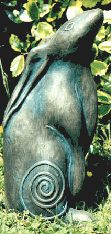
Image: Subject and photographer unknown.
 There was a table set out under a tree in front of the house, and the March Hare and the Hatter were having tea at it: a Dormouse was sitting between them, fast asleep, and the other two were using it as a cushion, resting their elbows on it, and talking over its head. “Very uncomfortable for the Dormouse,” thought Alice; “only, as it’s asleep, I suppose it doesn’t mind.”
There was a table set out under a tree in front of the house, and the March Hare and the Hatter were having tea at it: a Dormouse was sitting between them, fast asleep, and the other two were using it as a cushion, resting their elbows on it, and talking over its head. “Very uncomfortable for the Dormouse,” thought Alice; “only, as it’s asleep, I suppose it doesn’t mind.”







NOTE: I've had reports of readers not being able to access this blog and/or pages of it because they get stuck on the “Sensitive Content” warning page which redirects back to itself every time they try to click through. I'm not sure what the issue is, though it might be a problem stemming from when the site shifted from http to https. Accordingly, it should be resolved when you add https:// to the front of the link for the page you are trying to access.